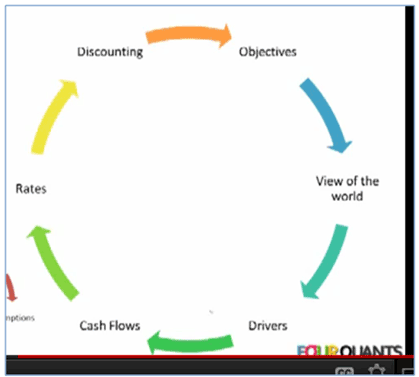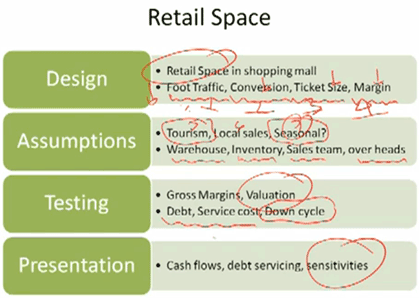In the first video session of our Financial Modeling training course we cover the following topics:
- A quick review of the reasons why financial models are built and used.
- Principles for designing a great financial model
- How the financial modeling process may be applied to 3 very different situations. We look at retail spaces, a power plant and a MTM model for cross currency swaps
Reasons for building and using financial models

There are a number of reasons why financial models are used. These include:
- Pricing and valuation of various financial instruments such as Cross Currency Swaps. The methodology that we most commonly employ in valuing these instruments is the Discounted Cash Flow or DCF approach. In this approach future cash flows are discounted using appropriate interest rates, and then aggregated to determine the net present value (NPV) or model price of the instrument. Other hybrid approaches that use the DCF method as well as some closed form solution, such as Black’s formula to value caps& floors, may also be employed.
- Comparing and analyzing a number of investment choices in order to select or make a recommendation on the relatively better option. To illustrate this we will look at an example that involves choosing an optimal retail space.
- Deciding on the manner in which an investment will be funded. In this instance we will look at a particular power plant and use financial modeling to determine the degree of leverage that can be supported by the given project.
Other applications of financial modeling are also briefly considered such as its relevance to;
- Trading, in particular in predicting where the market would be so that decisions regarding making and executing trades may be made. This usually employs a forward looking approach.
- Risk, in particular in collaboration with various risk measurement and management tools such as Value at Risk (VaR) and limits. Contrary to its application in trading these models tend to utilize historical data, specifically with regard to what may be learned from the past.
- Simulation. This particular use has utility in other financial modeling applications like investment decisions, valuations, trading, risk and funding decisions. The primary mechanism used is a Monte Carlo simulator. Simulations are particularly useful for carrying out sensitivity tests of results and scenario analysis. They are usually forward looking tools but may also make use of historical data in their construction.
Design elements of Financial Model building
We then move on to the design elements of building a great model. Before proceeding it is important to note that many advanced models are built in layers where each layer is in itself a model. This layering of sub-models allows for a higher level of analysis and stress testing.
The principles of building a great model include:
- Identifying the objectives of the model (e.g. simulate oil prices)
- Considering the views of the world (e.g. what are the relationships with respect to oil? Are oil prices going to move up or down?)
- Considering the drivers (e.g. what are the factors that cause oils prices to go up or down?)
- Determine the Cash flows (e.g. how does the price movement impact the cash flows of the power plant?)
- Rates (e.g. what are the rates that will be used to discount cash flows?)
- Discounting and determining the NPV
A model design framework takes into consideration how and to whom the model results will be presented. It includes the following elements:
- Design which is based on the principles given above
- Assumptions on which the model will be based and run. These take into account the view of the world and the drivers mentioned earlier.
- Testing of assumptions and results
- Presentation which depends on the audience for the results. When it’s the Board recommendations need to be given and the presenter has to be ready to defend the choice made as well as be ready walkthrough if necessary. When its investors and analysts then it involves the presentation of results, assumptions and the data that validates both of these. In addition to presentation of results, presentations also may include presenting a forecast analysis as well as sensitivity of results. The latter case involves the identification of a relevant metric or target account and the illustration of the impact of changes in these metrics on the results.
- Results
Structuring excel spread sheets for financial models
Usually this would involve separate spread sheets for
- the assumptions;
- drivers behind the assumptions which in turn could be separate sub-models;
- a master page that presents the results;
- stress testing and sensitivity testing of those results
Finally there would be a presentation or summary of the results where the level of detail shown would be dictated by the audience for those results.
Examples
The session moves on to the 3 primary examples (Retail Space, Power Plant, Cross Currency Swaps) presenting an overview of how the principles of designing a great model and the elements of the model design framework may be applied to each.
In later sessions we will be extending our discussion to reviewing detailed model building exercises for each of these 3 examples.



